Layers of Intangibles Across Intelligent Learning Ecosystems
VerifiedAdded on 2022/09/12
|11
|2187
|30
AI Summary
Contribute Materials
Your contribution can guide someone’s learning journey. Share your
documents today.
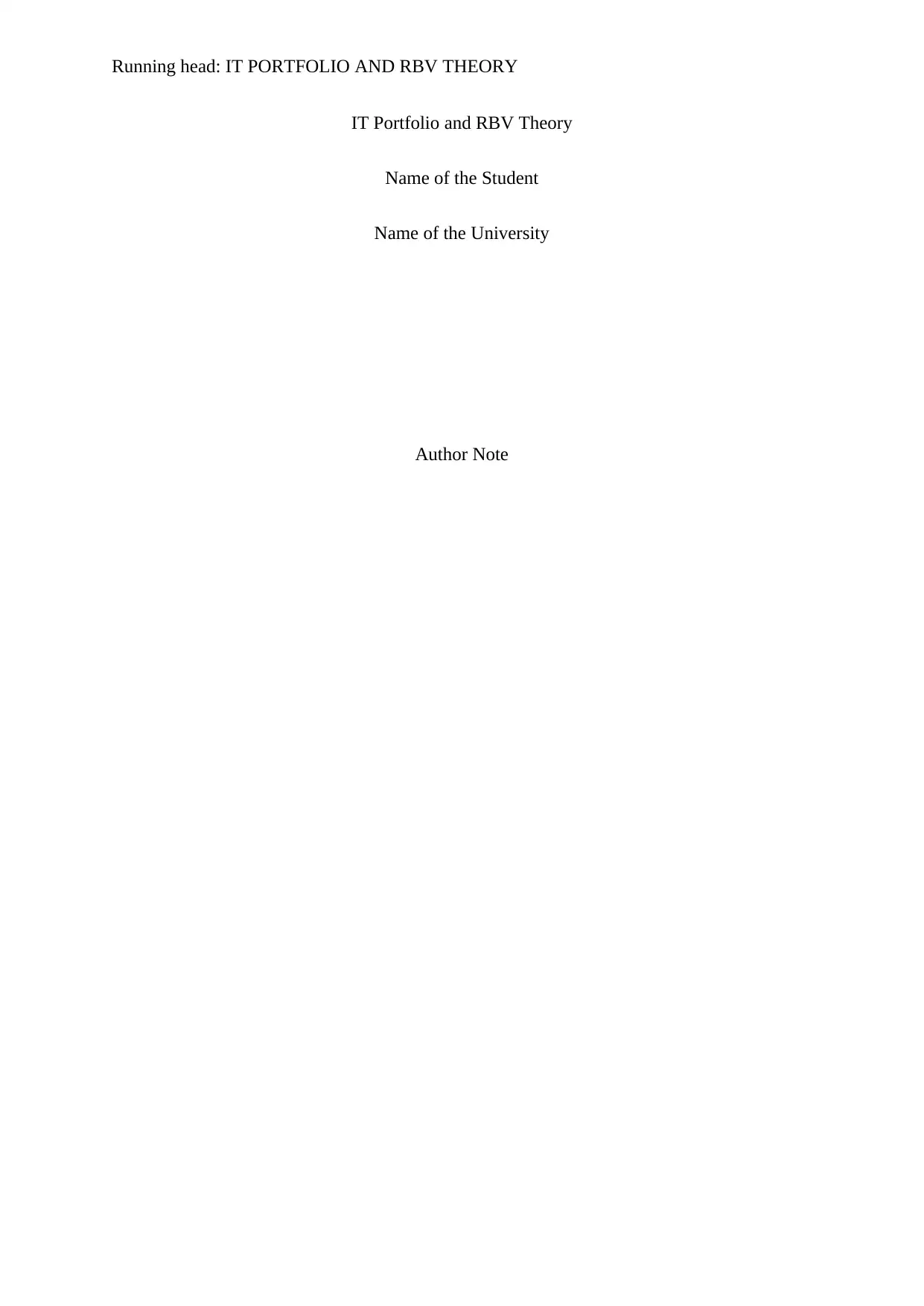
Running head: IT PORTFOLIO AND RBV THEORY
IT Portfolio and RBV Theory
Name of the Student
Name of the University
Author Note
IT Portfolio and RBV Theory
Name of the Student
Name of the University
Author Note
Secure Best Marks with AI Grader
Need help grading? Try our AI Grader for instant feedback on your assignments.
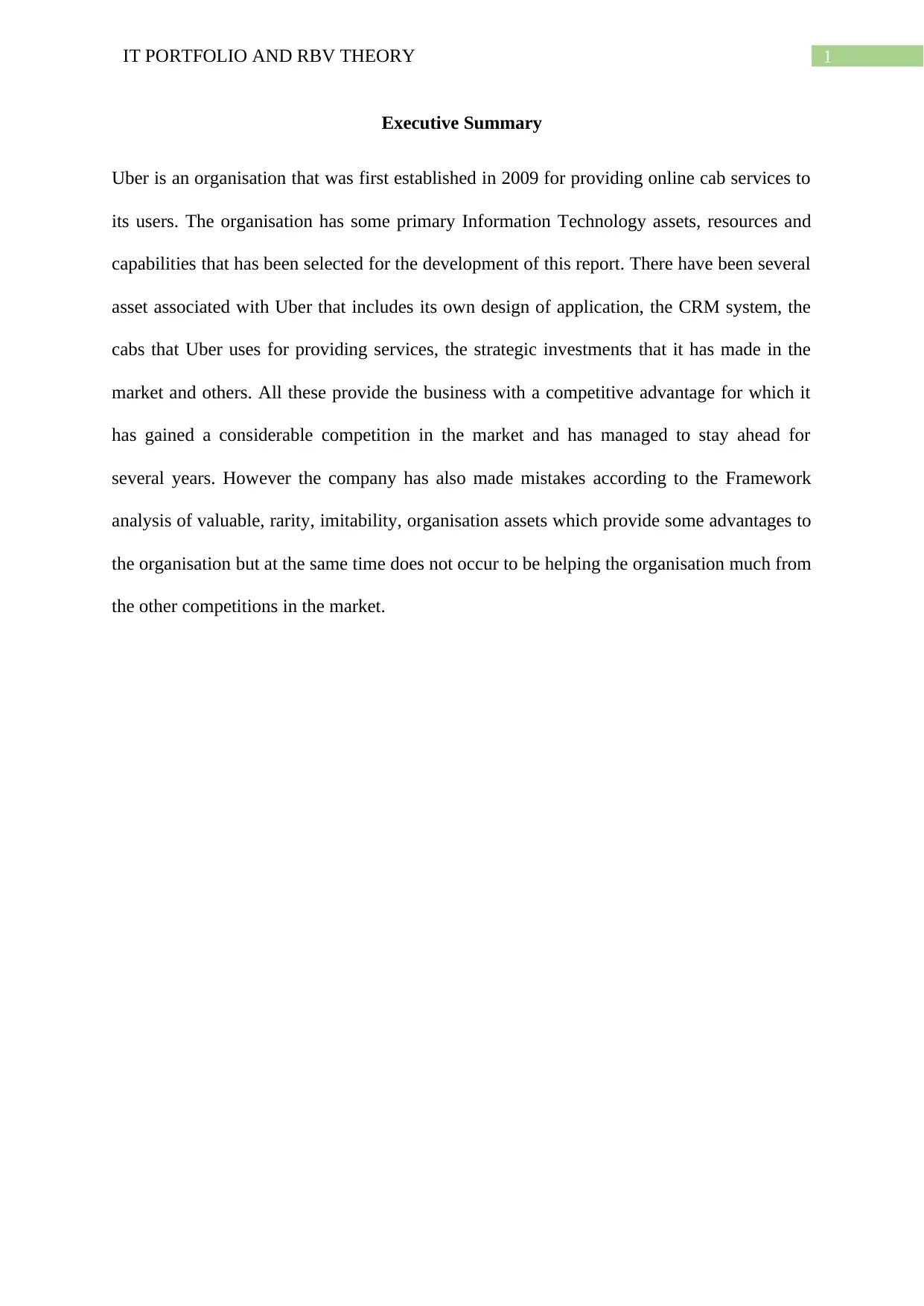
1IT PORTFOLIO AND RBV THEORY
Executive Summary
Uber is an organisation that was first established in 2009 for providing online cab services to
its users. The organisation has some primary Information Technology assets, resources and
capabilities that has been selected for the development of this report. There have been several
asset associated with Uber that includes its own design of application, the CRM system, the
cabs that Uber uses for providing services, the strategic investments that it has made in the
market and others. All these provide the business with a competitive advantage for which it
has gained a considerable competition in the market and has managed to stay ahead for
several years. However the company has also made mistakes according to the Framework
analysis of valuable, rarity, imitability, organisation assets which provide some advantages to
the organisation but at the same time does not occur to be helping the organisation much from
the other competitions in the market.
Executive Summary
Uber is an organisation that was first established in 2009 for providing online cab services to
its users. The organisation has some primary Information Technology assets, resources and
capabilities that has been selected for the development of this report. There have been several
asset associated with Uber that includes its own design of application, the CRM system, the
cabs that Uber uses for providing services, the strategic investments that it has made in the
market and others. All these provide the business with a competitive advantage for which it
has gained a considerable competition in the market and has managed to stay ahead for
several years. However the company has also made mistakes according to the Framework
analysis of valuable, rarity, imitability, organisation assets which provide some advantages to
the organisation but at the same time does not occur to be helping the organisation much from
the other competitions in the market.
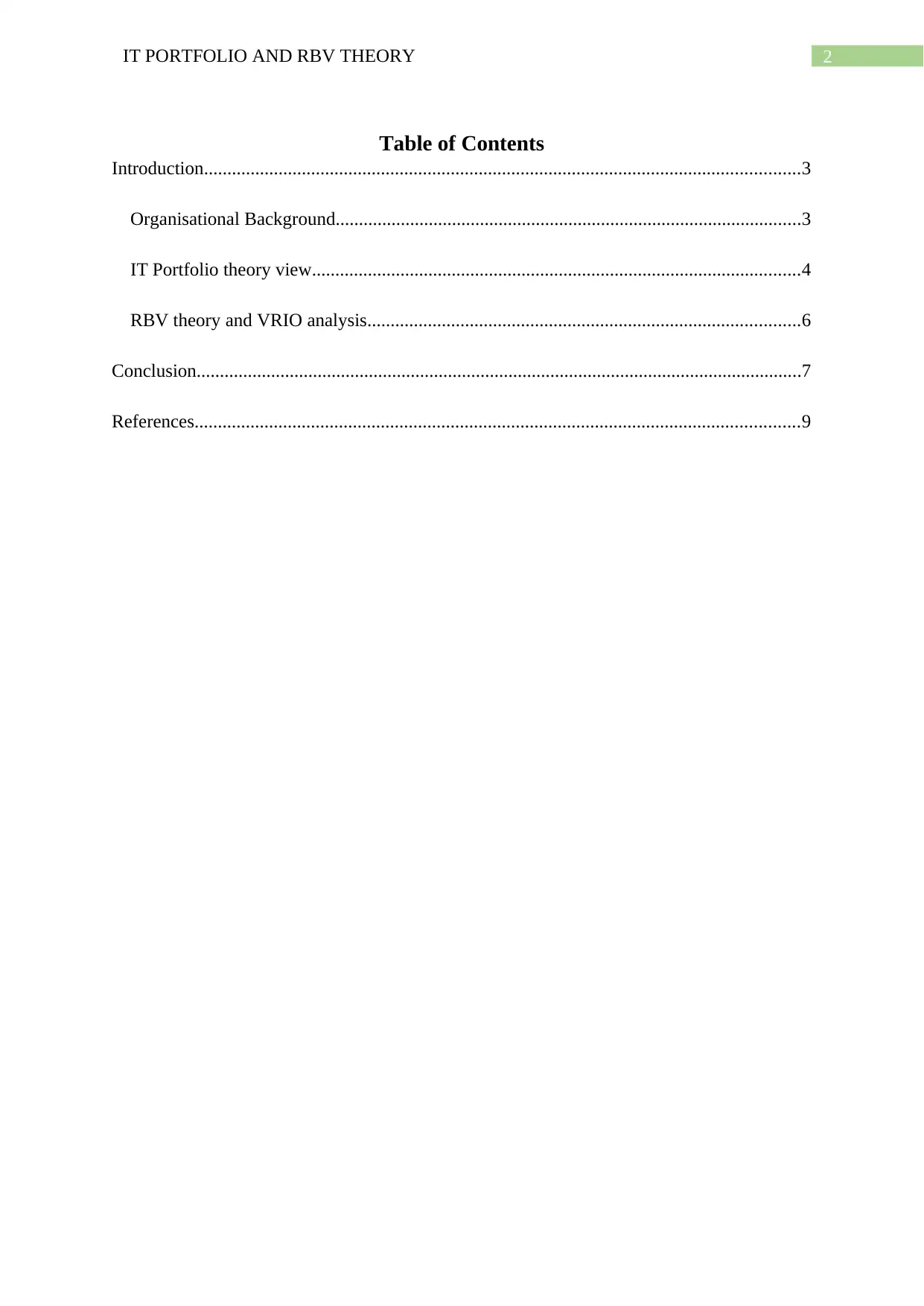
2IT PORTFOLIO AND RBV THEORY
Table of Contents
Introduction................................................................................................................................3
Organisational Background....................................................................................................3
IT Portfolio theory view.........................................................................................................4
RBV theory and VRIO analysis.............................................................................................6
Conclusion..................................................................................................................................7
References..................................................................................................................................9
Table of Contents
Introduction................................................................................................................................3
Organisational Background....................................................................................................3
IT Portfolio theory view.........................................................................................................4
RBV theory and VRIO analysis.............................................................................................6
Conclusion..................................................................................................................................7
References..................................................................................................................................9
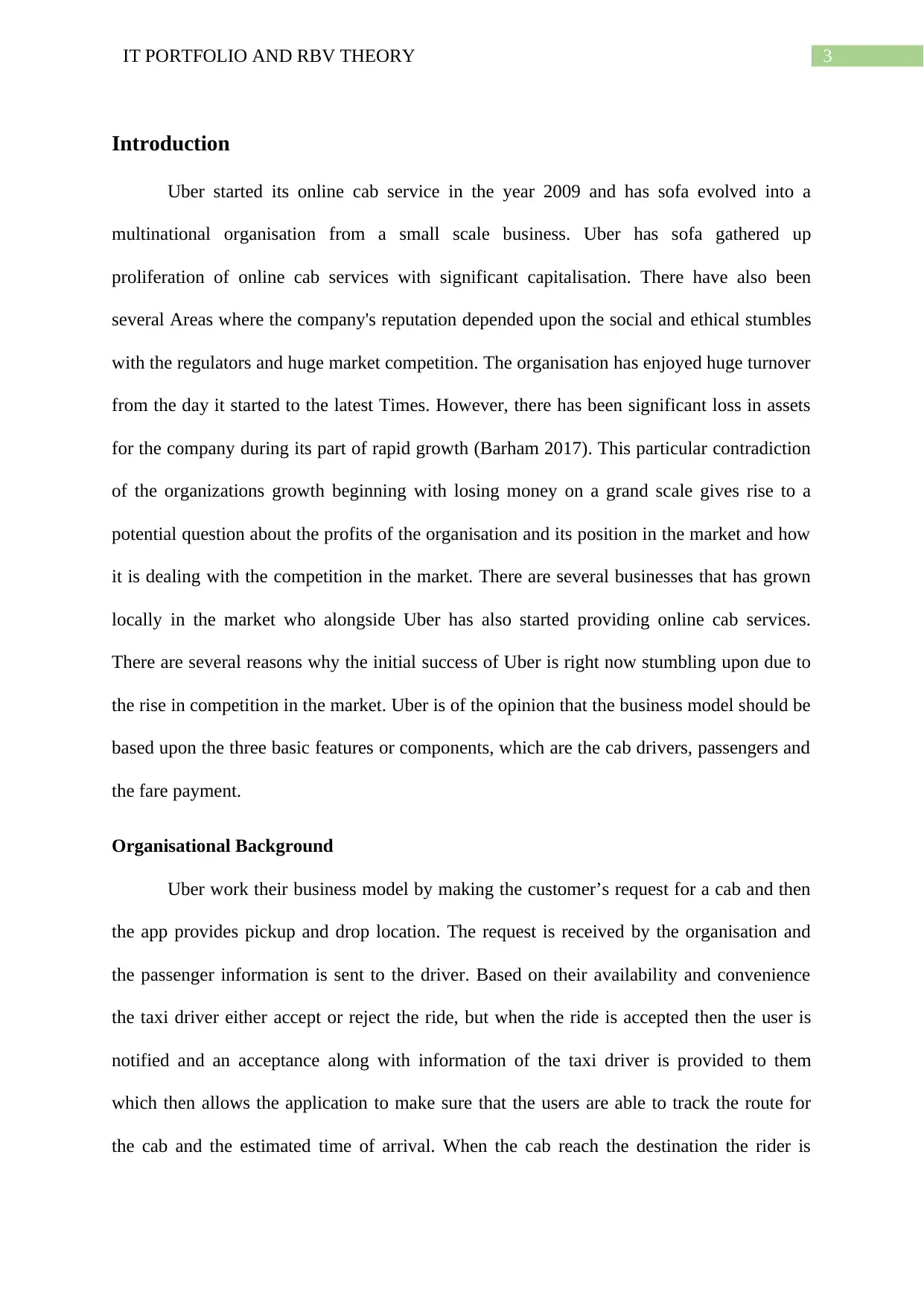
3IT PORTFOLIO AND RBV THEORY
Introduction
Uber started its online cab service in the year 2009 and has sofa evolved into a
multinational organisation from a small scale business. Uber has sofa gathered up
proliferation of online cab services with significant capitalisation. There have also been
several Areas where the company's reputation depended upon the social and ethical stumbles
with the regulators and huge market competition. The organisation has enjoyed huge turnover
from the day it started to the latest Times. However, there has been significant loss in assets
for the company during its part of rapid growth (Barham 2017). This particular contradiction
of the organizations growth beginning with losing money on a grand scale gives rise to a
potential question about the profits of the organisation and its position in the market and how
it is dealing with the competition in the market. There are several businesses that has grown
locally in the market who alongside Uber has also started providing online cab services.
There are several reasons why the initial success of Uber is right now stumbling upon due to
the rise in competition in the market. Uber is of the opinion that the business model should be
based upon the three basic features or components, which are the cab drivers, passengers and
the fare payment.
Organisational Background
Uber work their business model by making the customer’s request for a cab and then
the app provides pickup and drop location. The request is received by the organisation and
the passenger information is sent to the driver. Based on their availability and convenience
the taxi driver either accept or reject the ride, but when the ride is accepted then the user is
notified and an acceptance along with information of the taxi driver is provided to them
which then allows the application to make sure that the users are able to track the route for
the cab and the estimated time of arrival. When the cab reach the destination the rider is
Introduction
Uber started its online cab service in the year 2009 and has sofa evolved into a
multinational organisation from a small scale business. Uber has sofa gathered up
proliferation of online cab services with significant capitalisation. There have also been
several Areas where the company's reputation depended upon the social and ethical stumbles
with the regulators and huge market competition. The organisation has enjoyed huge turnover
from the day it started to the latest Times. However, there has been significant loss in assets
for the company during its part of rapid growth (Barham 2017). This particular contradiction
of the organizations growth beginning with losing money on a grand scale gives rise to a
potential question about the profits of the organisation and its position in the market and how
it is dealing with the competition in the market. There are several businesses that has grown
locally in the market who alongside Uber has also started providing online cab services.
There are several reasons why the initial success of Uber is right now stumbling upon due to
the rise in competition in the market. Uber is of the opinion that the business model should be
based upon the three basic features or components, which are the cab drivers, passengers and
the fare payment.
Organisational Background
Uber work their business model by making the customer’s request for a cab and then
the app provides pickup and drop location. The request is received by the organisation and
the passenger information is sent to the driver. Based on their availability and convenience
the taxi driver either accept or reject the ride, but when the ride is accepted then the user is
notified and an acceptance along with information of the taxi driver is provided to them
which then allows the application to make sure that the users are able to track the route for
the cab and the estimated time of arrival. When the cab reach the destination the rider is
Secure Best Marks with AI Grader
Need help grading? Try our AI Grader for instant feedback on your assignments.
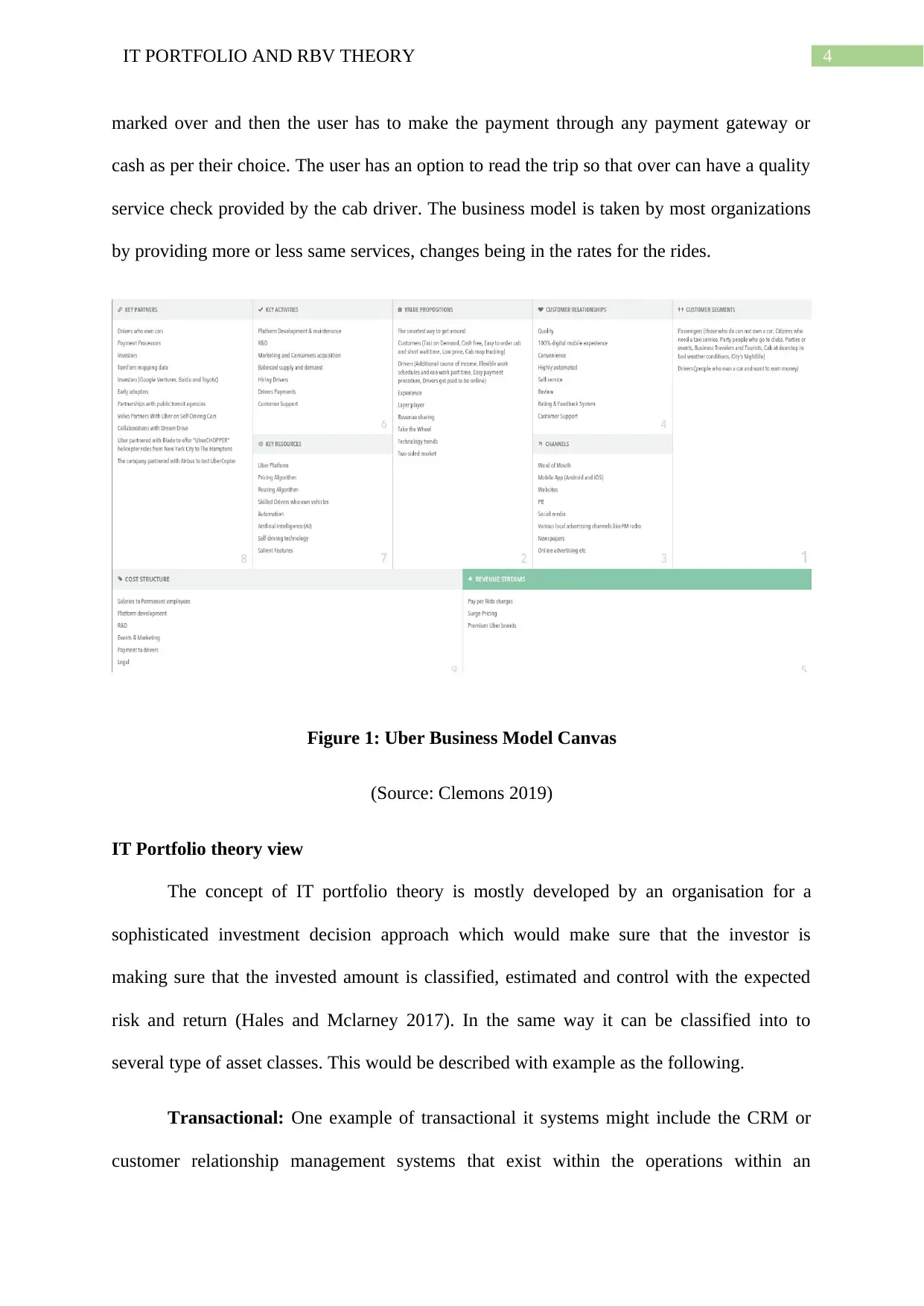
4IT PORTFOLIO AND RBV THEORY
marked over and then the user has to make the payment through any payment gateway or
cash as per their choice. The user has an option to read the trip so that over can have a quality
service check provided by the cab driver. The business model is taken by most organizations
by providing more or less same services, changes being in the rates for the rides.
Figure 1: Uber Business Model Canvas
(Source: Clemons 2019)
IT Portfolio theory view
The concept of IT portfolio theory is mostly developed by an organisation for a
sophisticated investment decision approach which would make sure that the investor is
making sure that the invested amount is classified, estimated and control with the expected
risk and return (Hales and Mclarney 2017). In the same way it can be classified into to
several type of asset classes. This would be described with example as the following.
Transactional: One example of transactional it systems might include the CRM or
customer relationship management systems that exist within the operations within an
marked over and then the user has to make the payment through any payment gateway or
cash as per their choice. The user has an option to read the trip so that over can have a quality
service check provided by the cab driver. The business model is taken by most organizations
by providing more or less same services, changes being in the rates for the rides.
Figure 1: Uber Business Model Canvas
(Source: Clemons 2019)
IT Portfolio theory view
The concept of IT portfolio theory is mostly developed by an organisation for a
sophisticated investment decision approach which would make sure that the investor is
making sure that the invested amount is classified, estimated and control with the expected
risk and return (Hales and Mclarney 2017). In the same way it can be classified into to
several type of asset classes. This would be described with example as the following.
Transactional: One example of transactional it systems might include the CRM or
customer relationship management systems that exist within the operations within an
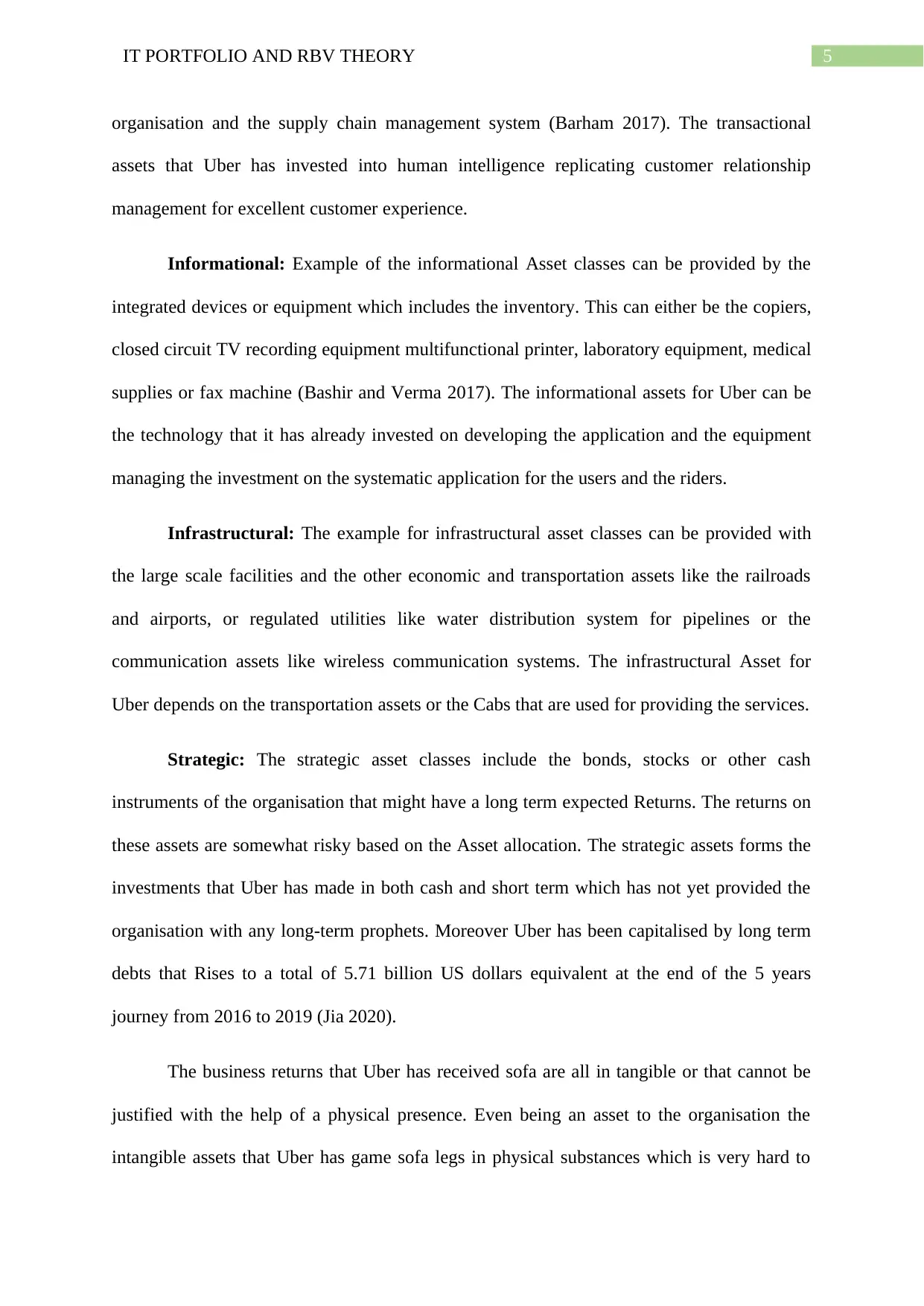
5IT PORTFOLIO AND RBV THEORY
organisation and the supply chain management system (Barham 2017). The transactional
assets that Uber has invested into human intelligence replicating customer relationship
management for excellent customer experience.
Informational: Example of the informational Asset classes can be provided by the
integrated devices or equipment which includes the inventory. This can either be the copiers,
closed circuit TV recording equipment multifunctional printer, laboratory equipment, medical
supplies or fax machine (Bashir and Verma 2017). The informational assets for Uber can be
the technology that it has already invested on developing the application and the equipment
managing the investment on the systematic application for the users and the riders.
Infrastructural: The example for infrastructural asset classes can be provided with
the large scale facilities and the other economic and transportation assets like the railroads
and airports, or regulated utilities like water distribution system for pipelines or the
communication assets like wireless communication systems. The infrastructural Asset for
Uber depends on the transportation assets or the Cabs that are used for providing the services.
Strategic: The strategic asset classes include the bonds, stocks or other cash
instruments of the organisation that might have a long term expected Returns. The returns on
these assets are somewhat risky based on the Asset allocation. The strategic assets forms the
investments that Uber has made in both cash and short term which has not yet provided the
organisation with any long-term prophets. Moreover Uber has been capitalised by long term
debts that Rises to a total of 5.71 billion US dollars equivalent at the end of the 5 years
journey from 2016 to 2019 (Jia 2020).
The business returns that Uber has received sofa are all in tangible or that cannot be
justified with the help of a physical presence. Even being an asset to the organisation the
intangible assets that Uber has game sofa legs in physical substances which is very hard to
organisation and the supply chain management system (Barham 2017). The transactional
assets that Uber has invested into human intelligence replicating customer relationship
management for excellent customer experience.
Informational: Example of the informational Asset classes can be provided by the
integrated devices or equipment which includes the inventory. This can either be the copiers,
closed circuit TV recording equipment multifunctional printer, laboratory equipment, medical
supplies or fax machine (Bashir and Verma 2017). The informational assets for Uber can be
the technology that it has already invested on developing the application and the equipment
managing the investment on the systematic application for the users and the riders.
Infrastructural: The example for infrastructural asset classes can be provided with
the large scale facilities and the other economic and transportation assets like the railroads
and airports, or regulated utilities like water distribution system for pipelines or the
communication assets like wireless communication systems. The infrastructural Asset for
Uber depends on the transportation assets or the Cabs that are used for providing the services.
Strategic: The strategic asset classes include the bonds, stocks or other cash
instruments of the organisation that might have a long term expected Returns. The returns on
these assets are somewhat risky based on the Asset allocation. The strategic assets forms the
investments that Uber has made in both cash and short term which has not yet provided the
organisation with any long-term prophets. Moreover Uber has been capitalised by long term
debts that Rises to a total of 5.71 billion US dollars equivalent at the end of the 5 years
journey from 2016 to 2019 (Jia 2020).
The business returns that Uber has received sofa are all in tangible or that cannot be
justified with the help of a physical presence. Even being an asset to the organisation the
intangible assets that Uber has game sofa legs in physical substances which is very hard to
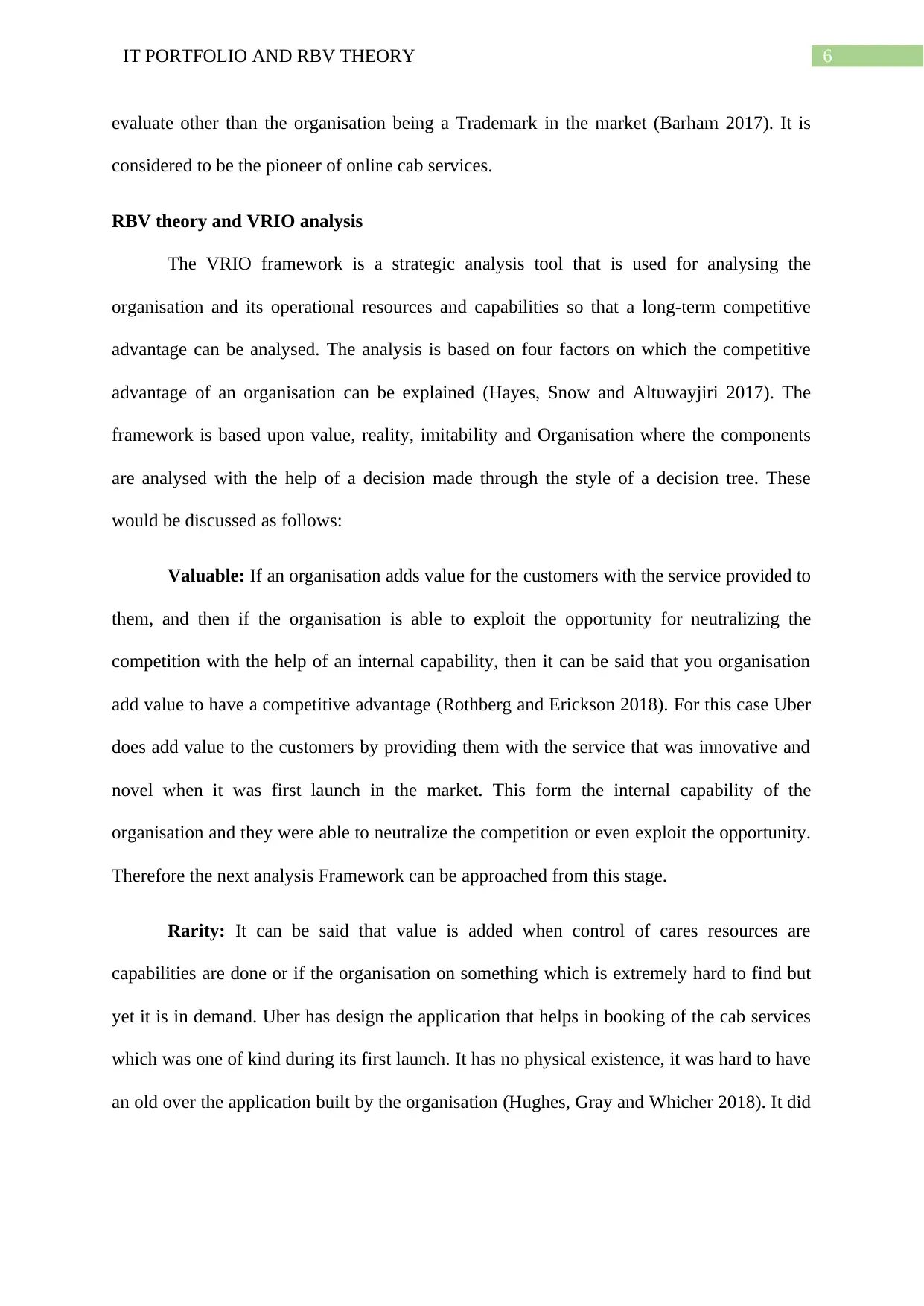
6IT PORTFOLIO AND RBV THEORY
evaluate other than the organisation being a Trademark in the market (Barham 2017). It is
considered to be the pioneer of online cab services.
RBV theory and VRIO analysis
The VRIO framework is a strategic analysis tool that is used for analysing the
organisation and its operational resources and capabilities so that a long-term competitive
advantage can be analysed. The analysis is based on four factors on which the competitive
advantage of an organisation can be explained (Hayes, Snow and Altuwayjiri 2017). The
framework is based upon value, reality, imitability and Organisation where the components
are analysed with the help of a decision made through the style of a decision tree. These
would be discussed as follows:
Valuable: If an organisation adds value for the customers with the service provided to
them, and then if the organisation is able to exploit the opportunity for neutralizing the
competition with the help of an internal capability, then it can be said that you organisation
add value to have a competitive advantage (Rothberg and Erickson 2018). For this case Uber
does add value to the customers by providing them with the service that was innovative and
novel when it was first launch in the market. This form the internal capability of the
organisation and they were able to neutralize the competition or even exploit the opportunity.
Therefore the next analysis Framework can be approached from this stage.
Rarity: It can be said that value is added when control of cares resources are
capabilities are done or if the organisation on something which is extremely hard to find but
yet it is in demand. Uber has design the application that helps in booking of the cab services
which was one of kind during its first launch. It has no physical existence, it was hard to have
an old over the application built by the organisation (Hughes, Gray and Whicher 2018). It did
evaluate other than the organisation being a Trademark in the market (Barham 2017). It is
considered to be the pioneer of online cab services.
RBV theory and VRIO analysis
The VRIO framework is a strategic analysis tool that is used for analysing the
organisation and its operational resources and capabilities so that a long-term competitive
advantage can be analysed. The analysis is based on four factors on which the competitive
advantage of an organisation can be explained (Hayes, Snow and Altuwayjiri 2017). The
framework is based upon value, reality, imitability and Organisation where the components
are analysed with the help of a decision made through the style of a decision tree. These
would be discussed as follows:
Valuable: If an organisation adds value for the customers with the service provided to
them, and then if the organisation is able to exploit the opportunity for neutralizing the
competition with the help of an internal capability, then it can be said that you organisation
add value to have a competitive advantage (Rothberg and Erickson 2018). For this case Uber
does add value to the customers by providing them with the service that was innovative and
novel when it was first launch in the market. This form the internal capability of the
organisation and they were able to neutralize the competition or even exploit the opportunity.
Therefore the next analysis Framework can be approached from this stage.
Rarity: It can be said that value is added when control of cares resources are
capabilities are done or if the organisation on something which is extremely hard to find but
yet it is in demand. Uber has design the application that helps in booking of the cab services
which was one of kind during its first launch. It has no physical existence, it was hard to have
an old over the application built by the organisation (Hughes, Gray and Whicher 2018). It did
Paraphrase This Document
Need a fresh take? Get an instant paraphrase of this document with our AI Paraphraser
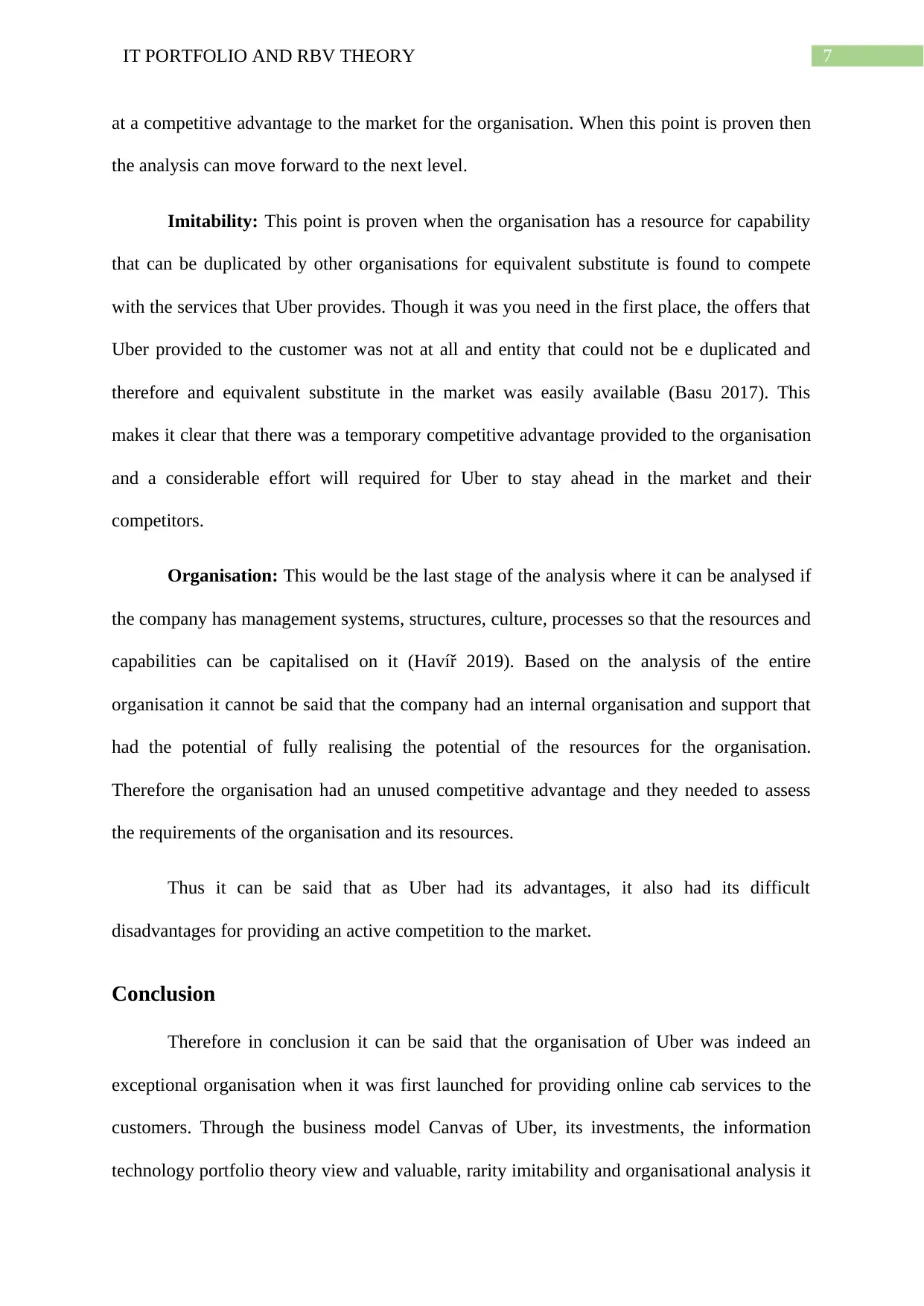
7IT PORTFOLIO AND RBV THEORY
at a competitive advantage to the market for the organisation. When this point is proven then
the analysis can move forward to the next level.
Imitability: This point is proven when the organisation has a resource for capability
that can be duplicated by other organisations for equivalent substitute is found to compete
with the services that Uber provides. Though it was you need in the first place, the offers that
Uber provided to the customer was not at all and entity that could not be e duplicated and
therefore and equivalent substitute in the market was easily available (Basu 2017). This
makes it clear that there was a temporary competitive advantage provided to the organisation
and a considerable effort will required for Uber to stay ahead in the market and their
competitors.
Organisation: This would be the last stage of the analysis where it can be analysed if
the company has management systems, structures, culture, processes so that the resources and
capabilities can be capitalised on it (Havíř 2019). Based on the analysis of the entire
organisation it cannot be said that the company had an internal organisation and support that
had the potential of fully realising the potential of the resources for the organisation.
Therefore the organisation had an unused competitive advantage and they needed to assess
the requirements of the organisation and its resources.
Thus it can be said that as Uber had its advantages, it also had its difficult
disadvantages for providing an active competition to the market.
Conclusion
Therefore in conclusion it can be said that the organisation of Uber was indeed an
exceptional organisation when it was first launched for providing online cab services to the
customers. Through the business model Canvas of Uber, its investments, the information
technology portfolio theory view and valuable, rarity imitability and organisational analysis it
at a competitive advantage to the market for the organisation. When this point is proven then
the analysis can move forward to the next level.
Imitability: This point is proven when the organisation has a resource for capability
that can be duplicated by other organisations for equivalent substitute is found to compete
with the services that Uber provides. Though it was you need in the first place, the offers that
Uber provided to the customer was not at all and entity that could not be e duplicated and
therefore and equivalent substitute in the market was easily available (Basu 2017). This
makes it clear that there was a temporary competitive advantage provided to the organisation
and a considerable effort will required for Uber to stay ahead in the market and their
competitors.
Organisation: This would be the last stage of the analysis where it can be analysed if
the company has management systems, structures, culture, processes so that the resources and
capabilities can be capitalised on it (Havíř 2019). Based on the analysis of the entire
organisation it cannot be said that the company had an internal organisation and support that
had the potential of fully realising the potential of the resources for the organisation.
Therefore the organisation had an unused competitive advantage and they needed to assess
the requirements of the organisation and its resources.
Thus it can be said that as Uber had its advantages, it also had its difficult
disadvantages for providing an active competition to the market.
Conclusion
Therefore in conclusion it can be said that the organisation of Uber was indeed an
exceptional organisation when it was first launched for providing online cab services to the
customers. Through the business model Canvas of Uber, its investments, the information
technology portfolio theory view and valuable, rarity imitability and organisational analysis it
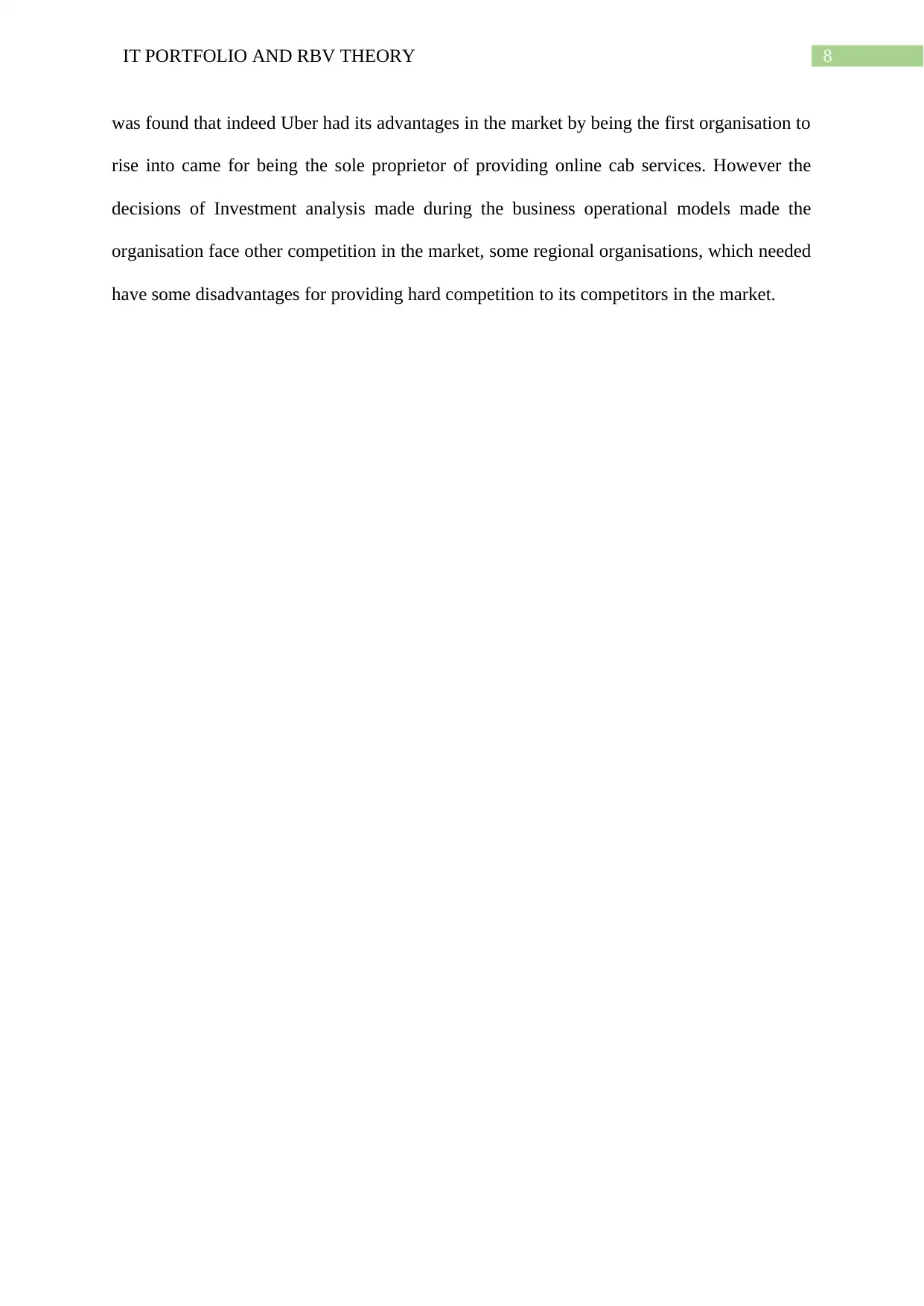
8IT PORTFOLIO AND RBV THEORY
was found that indeed Uber had its advantages in the market by being the first organisation to
rise into came for being the sole proprietor of providing online cab services. However the
decisions of Investment analysis made during the business operational models made the
organisation face other competition in the market, some regional organisations, which needed
have some disadvantages for providing hard competition to its competitors in the market.
was found that indeed Uber had its advantages in the market by being the first organisation to
rise into came for being the sole proprietor of providing online cab services. However the
decisions of Investment analysis made during the business operational models made the
organisation face other competition in the market, some regional organisations, which needed
have some disadvantages for providing hard competition to its competitors in the market.
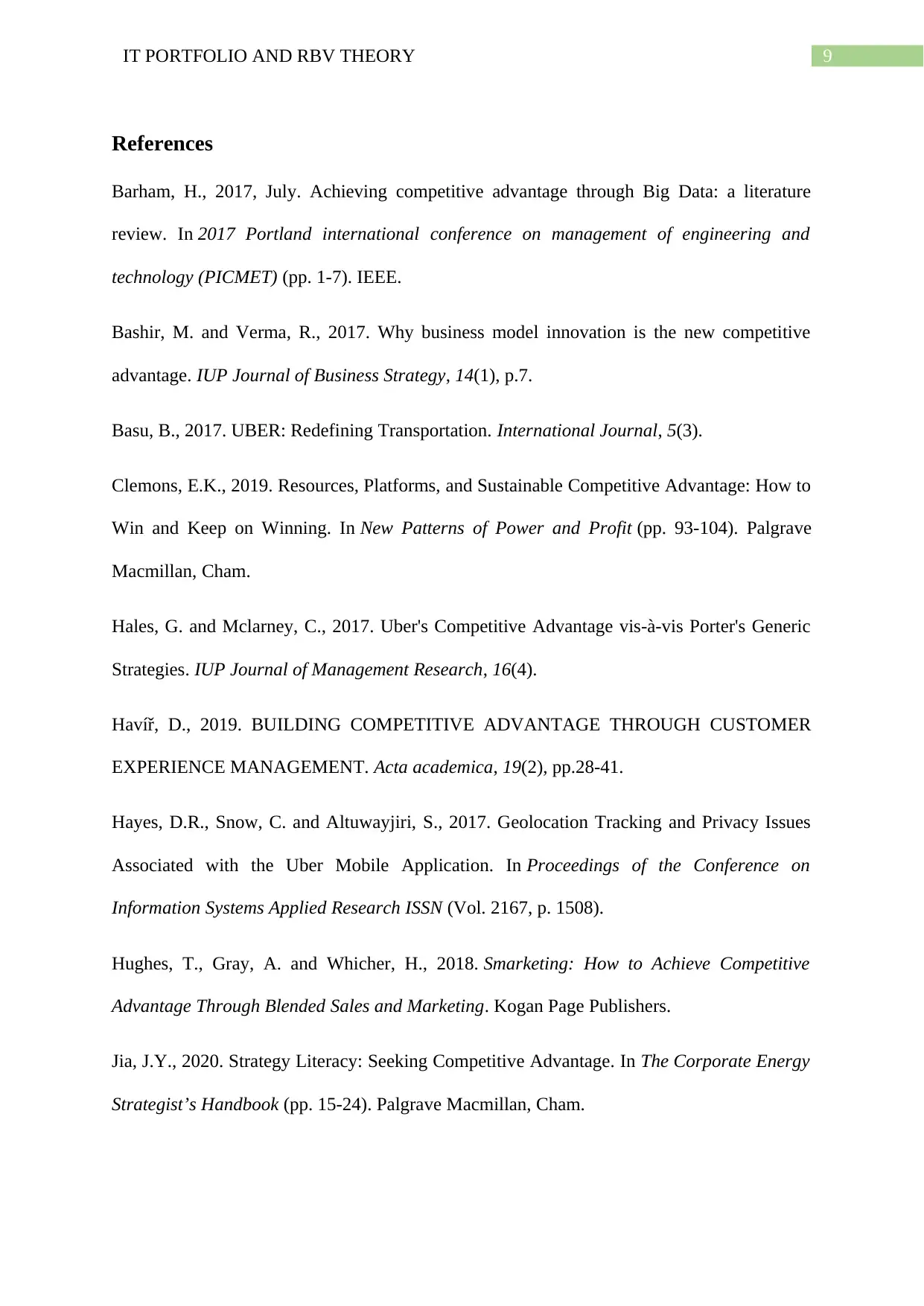
9IT PORTFOLIO AND RBV THEORY
References
Barham, H., 2017, July. Achieving competitive advantage through Big Data: a literature
review. In 2017 Portland international conference on management of engineering and
technology (PICMET) (pp. 1-7). IEEE.
Bashir, M. and Verma, R., 2017. Why business model innovation is the new competitive
advantage. IUP Journal of Business Strategy, 14(1), p.7.
Basu, B., 2017. UBER: Redefining Transportation. International Journal, 5(3).
Clemons, E.K., 2019. Resources, Platforms, and Sustainable Competitive Advantage: How to
Win and Keep on Winning. In New Patterns of Power and Profit (pp. 93-104). Palgrave
Macmillan, Cham.
Hales, G. and Mclarney, C., 2017. Uber's Competitive Advantage vis-à-vis Porter's Generic
Strategies. IUP Journal of Management Research, 16(4).
Havíř, D., 2019. BUILDING COMPETITIVE ADVANTAGE THROUGH CUSTOMER
EXPERIENCE MANAGEMENT. Acta academica, 19(2), pp.28-41.
Hayes, D.R., Snow, C. and Altuwayjiri, S., 2017. Geolocation Tracking and Privacy Issues
Associated with the Uber Mobile Application. In Proceedings of the Conference on
Information Systems Applied Research ISSN (Vol. 2167, p. 1508).
Hughes, T., Gray, A. and Whicher, H., 2018. Smarketing: How to Achieve Competitive
Advantage Through Blended Sales and Marketing. Kogan Page Publishers.
Jia, J.Y., 2020. Strategy Literacy: Seeking Competitive Advantage. In The Corporate Energy
Strategist’s Handbook (pp. 15-24). Palgrave Macmillan, Cham.
References
Barham, H., 2017, July. Achieving competitive advantage through Big Data: a literature
review. In 2017 Portland international conference on management of engineering and
technology (PICMET) (pp. 1-7). IEEE.
Bashir, M. and Verma, R., 2017. Why business model innovation is the new competitive
advantage. IUP Journal of Business Strategy, 14(1), p.7.
Basu, B., 2017. UBER: Redefining Transportation. International Journal, 5(3).
Clemons, E.K., 2019. Resources, Platforms, and Sustainable Competitive Advantage: How to
Win and Keep on Winning. In New Patterns of Power and Profit (pp. 93-104). Palgrave
Macmillan, Cham.
Hales, G. and Mclarney, C., 2017. Uber's Competitive Advantage vis-à-vis Porter's Generic
Strategies. IUP Journal of Management Research, 16(4).
Havíř, D., 2019. BUILDING COMPETITIVE ADVANTAGE THROUGH CUSTOMER
EXPERIENCE MANAGEMENT. Acta academica, 19(2), pp.28-41.
Hayes, D.R., Snow, C. and Altuwayjiri, S., 2017. Geolocation Tracking and Privacy Issues
Associated with the Uber Mobile Application. In Proceedings of the Conference on
Information Systems Applied Research ISSN (Vol. 2167, p. 1508).
Hughes, T., Gray, A. and Whicher, H., 2018. Smarketing: How to Achieve Competitive
Advantage Through Blended Sales and Marketing. Kogan Page Publishers.
Jia, J.Y., 2020. Strategy Literacy: Seeking Competitive Advantage. In The Corporate Energy
Strategist’s Handbook (pp. 15-24). Palgrave Macmillan, Cham.
Secure Best Marks with AI Grader
Need help grading? Try our AI Grader for instant feedback on your assignments.
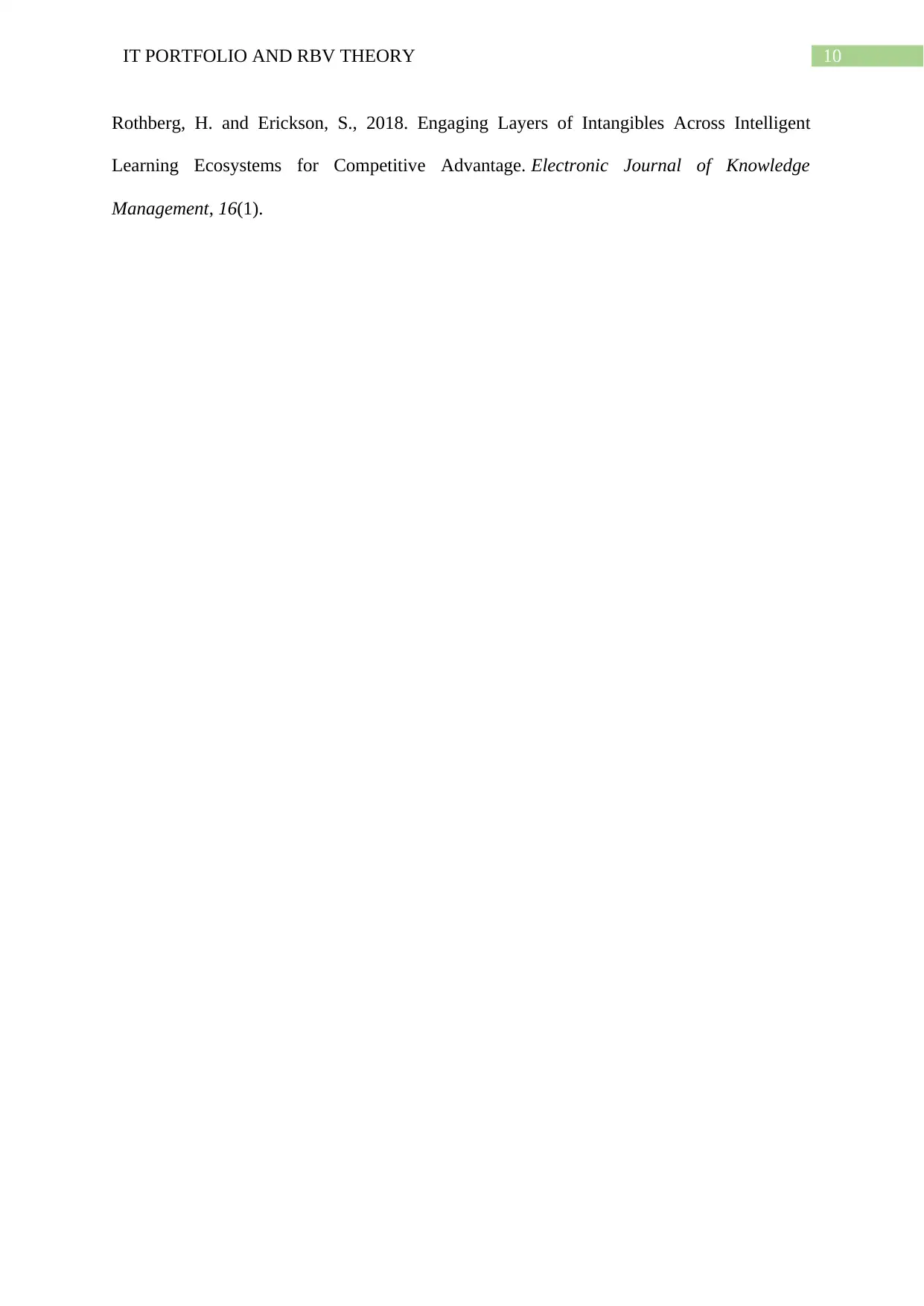
10IT PORTFOLIO AND RBV THEORY
Rothberg, H. and Erickson, S., 2018. Engaging Layers of Intangibles Across Intelligent
Learning Ecosystems for Competitive Advantage. Electronic Journal of Knowledge
Management, 16(1).
Rothberg, H. and Erickson, S., 2018. Engaging Layers of Intangibles Across Intelligent
Learning Ecosystems for Competitive Advantage. Electronic Journal of Knowledge
Management, 16(1).
1 out of 11
Related Documents
Your All-in-One AI-Powered Toolkit for Academic Success.
+13062052269
info@desklib.com
Available 24*7 on WhatsApp / Email
![[object Object]](/_next/static/media/star-bottom.7253800d.svg)
Unlock your academic potential
© 2024 | Zucol Services PVT LTD | All rights reserved.





